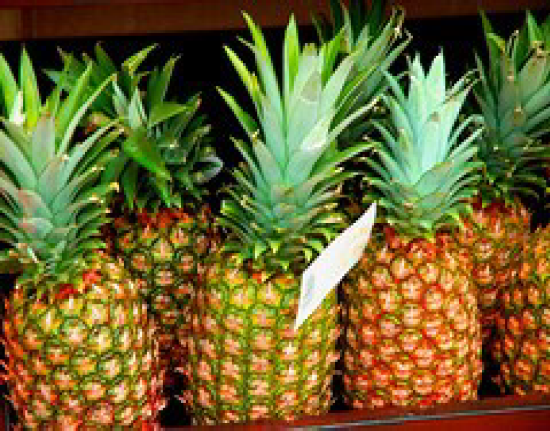9.5: Stone Fruits and Tropical Varieties
- Page ID
- 21623
\( \newcommand{\vecs}[1]{\overset { \scriptstyle \rightharpoonup} {\mathbf{#1}} } \)
\( \newcommand{\vecd}[1]{\overset{-\!-\!\rightharpoonup}{\vphantom{a}\smash {#1}}} \)
\( \newcommand{\id}{\mathrm{id}}\) \( \newcommand{\Span}{\mathrm{span}}\)
( \newcommand{\kernel}{\mathrm{null}\,}\) \( \newcommand{\range}{\mathrm{range}\,}\)
\( \newcommand{\RealPart}{\mathrm{Re}}\) \( \newcommand{\ImaginaryPart}{\mathrm{Im}}\)
\( \newcommand{\Argument}{\mathrm{Arg}}\) \( \newcommand{\norm}[1]{\| #1 \|}\)
\( \newcommand{\inner}[2]{\langle #1, #2 \rangle}\)
\( \newcommand{\Span}{\mathrm{span}}\)
\( \newcommand{\id}{\mathrm{id}}\)
\( \newcommand{\Span}{\mathrm{span}}\)
\( \newcommand{\kernel}{\mathrm{null}\,}\)
\( \newcommand{\range}{\mathrm{range}\,}\)
\( \newcommand{\RealPart}{\mathrm{Re}}\)
\( \newcommand{\ImaginaryPart}{\mathrm{Im}}\)
\( \newcommand{\Argument}{\mathrm{Arg}}\)
\( \newcommand{\norm}[1]{\| #1 \|}\)
\( \newcommand{\inner}[2]{\langle #1, #2 \rangle}\)
\( \newcommand{\Span}{\mathrm{span}}\) \( \newcommand{\AA}{\unicode[.8,0]{x212B}}\)
\( \newcommand{\vectorA}[1]{\vec{#1}} % arrow\)
\( \newcommand{\vectorAt}[1]{\vec{\text{#1}}} % arrow\)
\( \newcommand{\vectorB}[1]{\overset { \scriptstyle \rightharpoonup} {\mathbf{#1}} } \)
\( \newcommand{\vectorC}[1]{\textbf{#1}} \)
\( \newcommand{\vectorD}[1]{\overrightarrow{#1}} \)
\( \newcommand{\vectorDt}[1]{\overrightarrow{\text{#1}}} \)
\( \newcommand{\vectE}[1]{\overset{-\!-\!\rightharpoonup}{\vphantom{a}\smash{\mathbf {#1}}}} \)
\( \newcommand{\vecs}[1]{\overset { \scriptstyle \rightharpoonup} {\mathbf{#1}} } \)
\( \newcommand{\vecd}[1]{\overset{-\!-\!\rightharpoonup}{\vphantom{a}\smash {#1}}} \)
\(\newcommand{\avec}{\mathbf a}\) \(\newcommand{\bvec}{\mathbf b}\) \(\newcommand{\cvec}{\mathbf c}\) \(\newcommand{\dvec}{\mathbf d}\) \(\newcommand{\dtil}{\widetilde{\mathbf d}}\) \(\newcommand{\evec}{\mathbf e}\) \(\newcommand{\fvec}{\mathbf f}\) \(\newcommand{\nvec}{\mathbf n}\) \(\newcommand{\pvec}{\mathbf p}\) \(\newcommand{\qvec}{\mathbf q}\) \(\newcommand{\svec}{\mathbf s}\) \(\newcommand{\tvec}{\mathbf t}\) \(\newcommand{\uvec}{\mathbf u}\) \(\newcommand{\vvec}{\mathbf v}\) \(\newcommand{\wvec}{\mathbf w}\) \(\newcommand{\xvec}{\mathbf x}\) \(\newcommand{\yvec}{\mathbf y}\) \(\newcommand{\zvec}{\mathbf z}\) \(\newcommand{\rvec}{\mathbf r}\) \(\newcommand{\mvec}{\mathbf m}\) \(\newcommand{\zerovec}{\mathbf 0}\) \(\newcommand{\onevec}{\mathbf 1}\) \(\newcommand{\real}{\mathbb R}\) \(\newcommand{\twovec}[2]{\left[\begin{array}{r}#1 \\ #2 \end{array}\right]}\) \(\newcommand{\ctwovec}[2]{\left[\begin{array}{c}#1 \\ #2 \end{array}\right]}\) \(\newcommand{\threevec}[3]{\left[\begin{array}{r}#1 \\ #2 \\ #3 \end{array}\right]}\) \(\newcommand{\cthreevec}[3]{\left[\begin{array}{c}#1 \\ #2 \\ #3 \end{array}\right]}\) \(\newcommand{\fourvec}[4]{\left[\begin{array}{r}#1 \\ #2 \\ #3 \\ #4 \end{array}\right]}\) \(\newcommand{\cfourvec}[4]{\left[\begin{array}{c}#1 \\ #2 \\ #3 \\ #4 \end{array}\right]}\) \(\newcommand{\fivevec}[5]{\left[\begin{array}{r}#1 \\ #2 \\ #3 \\ #4 \\ #5 \\ \end{array}\right]}\) \(\newcommand{\cfivevec}[5]{\left[\begin{array}{c}#1 \\ #2 \\ #3 \\ #4 \\ #5 \\ \end{array}\right]}\) \(\newcommand{\mattwo}[4]{\left[\begin{array}{rr}#1 \amp #2 \\ #3 \amp #4 \\ \end{array}\right]}\) \(\newcommand{\laspan}[1]{\text{Span}\{#1\}}\) \(\newcommand{\bcal}{\cal B}\) \(\newcommand{\ccal}{\cal C}\) \(\newcommand{\scal}{\cal S}\) \(\newcommand{\wcal}{\cal W}\) \(\newcommand{\ecal}{\cal E}\) \(\newcommand{\coords}[2]{\left\{#1\right\}_{#2}}\) \(\newcommand{\gray}[1]{\color{gray}{#1}}\) \(\newcommand{\lgray}[1]{\color{lightgray}{#1}}\) \(\newcommand{\rank}{\operatorname{rank}}\) \(\newcommand{\row}{\text{Row}}\) \(\newcommand{\col}{\text{Col}}\) \(\renewcommand{\row}{\text{Row}}\) \(\newcommand{\nul}{\text{Nul}}\) \(\newcommand{\var}{\text{Var}}\) \(\newcommand{\corr}{\text{corr}}\) \(\newcommand{\len}[1]{\left|#1\right|}\) \(\newcommand{\bbar}{\overline{\bvec}}\) \(\newcommand{\bhat}{\widehat{\bvec}}\) \(\newcommand{\bperp}{\bvec^\perp}\) \(\newcommand{\xhat}{\widehat{\xvec}}\) \(\newcommand{\vhat}{\widehat{\vvec}}\) \(\newcommand{\uhat}{\widehat{\uvec}}\) \(\newcommand{\what}{\widehat{\wvec}}\) \(\newcommand{\Sighat}{\widehat{\Sigma}}\) \(\newcommand{\lt}{<}\) \(\newcommand{\gt}{>}\) \(\newcommand{\amp}{&}\) \(\definecolor{fillinmathshade}{gray}{0.9}\)Stone Fruits
Stone fruits, also known as drupes, include apricots, cherries, nectarines, peaches and plums. They are characterized by a thin skin, soft flesh and one woody stone or pit. Although most originated in China, the shrubs and trees producing stone fruits are now grown in temperate climates worldwide.
The domestic varieties of stone fruits are in season from late spring through summer. They tend to be fragile fruits, easily bruised and difficult to transport, and have a short shelf life. Do not wash them until ready to use, as moisture can cause deterioration. Stone fruits are excellent dried and are often used to make liqueurs and brandies. (The kernel inside the pits of many stone fruits contains amygdalin, a compound that has a bitter almond flavor. Eating the raw kernel can cause digestive discomfort or more serious side effects and should be avoided. When cooked it is harmless and can add flavor to jams and creams.)
Apricots
Apricots are small, round stone fruits with a velvety skin that varies from deep yellow to vivid orange. Their juicy orange flesh surrounds a dark, almond-shaped pit. Apricots can be eaten out of hand, poached, stewed, baked or candied. They are often used in fruit compotes or savory sauces for meat or poultry, and are also popular in quick breads and fruit tarts or pureed for dessert sauces, jams, custards or mousses.
Apricots have a short season, peaking during June and July, and do not travel well. Select apricots that are well shaped, plump and firm. Avoid ones that are greenish-yellow or mushy. Fresh apricots will last for several days under refrigeration, but the flavor is best at room temperature. If fresh fruits are unavailable, canned apricots are usually an acceptable substitute. Dried apricots and apricot juice (known as nectar) are readily available.
From the northern states, particularly Washington, Oregon, Michigan and New York, come the two most important types of cherry: the sweet cherry and the sour (or tart) cherry. Sweet cherries are round to heart-shaped, about 1 inch (2.5 centimeters) in diameter, with skin that ranges from yellow to deep red to nearly black. The flesh, which is sweet and juicy, may vary from yellow to dark red. The most common and popular sweet cherries are the dark red Bings. Yellow-red Royal Ann and Rainier cherries are also available in some areas.
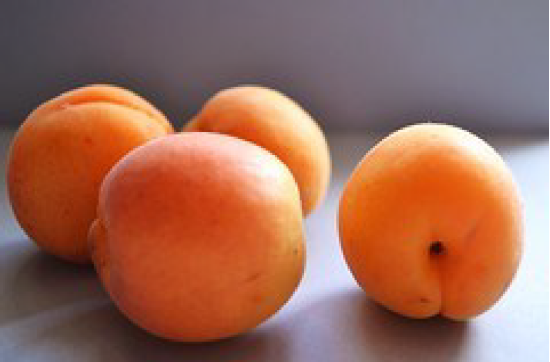
Cherries
Sweet cherries are often marketed fresh, made into maraschino cherries or candied for use in baked goods. Fresh sweet cherries have a very short season, peaking during June and July. Cherries will not ripen further after harvesting. Select fruits that are firm and plump with a green stem still attached. There should not be any brown spots around the stem. A dry or brown stem indicates that the cherry is less than fresh. Once the stem is removed, the cherry will deteriorate rapidly. Store fresh cherries in the refrigerator and do not wash them until ready to use.
Sour cherries are light to dark reel and are so acidic they are rarely eaten uncooked. The most common sour cherries are the Montmorency and Morello. Most sour cherries are canned or frozen, or cooked with sugar and starch (usually cornstarch or tapioca) and sold as prepared pastry and pie fillings.
Both sweet and sour varieties are available dried.
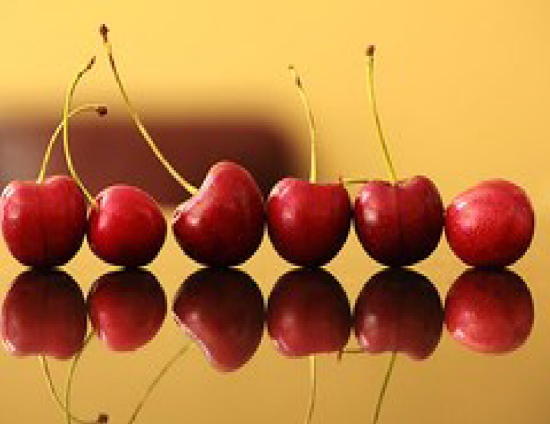
Peaches and Nectarines
Peaches are moderate-sized, round fruits with a juicy, sweet flesh. Nectarines are a variety of peach, the main difference between the two being their skin. Peaches have a thin skin covered with fuzz, while nectarines have a thin, smooth skin. The flesh of either fruit ranges from white to pale orange. Although their flavors are somewhat different, they may be substituted for each other in most recipes.
Peaches and nectarines are excellent for eating out of hand or in dessert tarts or pastries. They are also used in jams, chutneys, preserves and savory relishes, having a particular affinity for Asian and Indian dishes. Although the skin is edible, peaches are generally peeled before use. (Peaches peel easily if blanched first.)
Peaches and nectarines are either freestones or clingstones. With freestones, the flesh separates easily from the stone; free stone fruits are commonly eaten out of hand. The flesh of clingstones adheres firmly to the stone; they hold their shape better when cooked and are the type most often canned.
Select fruits with a good aroma; an overall creamy, yellow or yellow-orange color; and an unwrinkled skin free of blemishes. Red patches are not an indication of ripeness; a green skin indicates that the fruit was picked too early and it will not ripen further. Peaches and nectarines will soften but do not become sweeter after harvesting.
The United States, especially California, is the world's largest producer of peaches and nectarines. Their peak season is through the summer months, with July and August producing the best crop. South American peaches are sometimes available from January to May. Canned and frozen peaches are readily available.
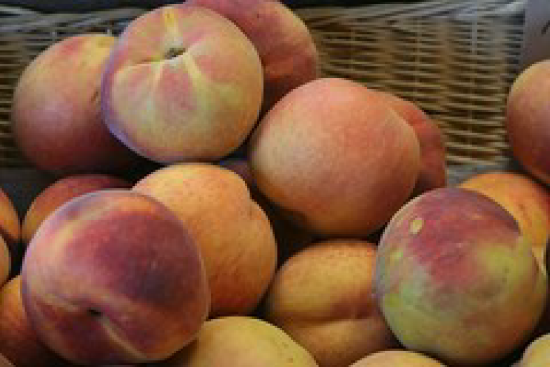
Plums
Plums are round to oval-shaped fruits that grow on trees or bushes. Dozens of plum varieties are known, although only a few are commercially significant. Plums vary in size from very small to 3 inches (7.5 centimeters) in diameter. Their thin skin can be green, red, yellow or various shades of blue-purple.
Plums are excellent for eating out of hand. Plums can also be baked, poached or used in pies, cobblers or tarts; they are often used in jams or preserves, and fresh slices can be used in salads or compotes.
Fresh plums are widely available from June through October; their peak season is in August and September. When selecting plums, look for plump, smooth fruits with unblemished skin. Generally, they should yield to gentle pressure, although the green and yellow varieties remain quite firm. Avoid plums with moist, brown spots near the stem. Plums may be left at room temperature to ripen, and then stored in the refrigerator.
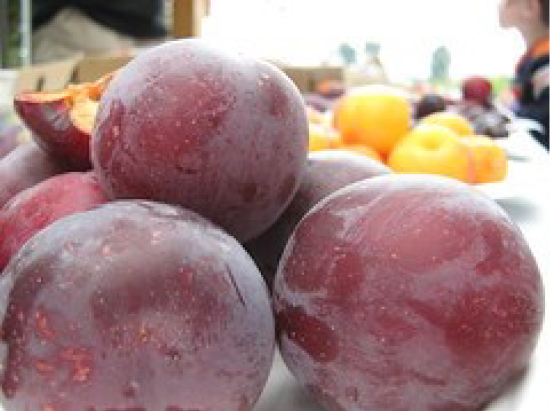
Tropicals
Tropical fruits are native to the world's hot, tropical or subtropical regions. Most are now readily available throughout the United States thanks to rapid transportation and distribution methods. All can be eaten fresh, without cooking. Their flavors complement each other and go well with rich or spicy meat, fish and poultry dishes.
Bananas
Common yellow bananas are actually the berries of a large tropical herb. Grown in bunches called hands, they are about 7 to 9 inches (17.5 to 22.5 centimeters) long, with a sticky, soft, sweet flesh. Their inedible yellow skin is easily removed. Baby bananas (Nino, Ladyfinger or Finger Bananas) measure 4 to 5 inches long (10 to 12.5 centimeters) with yellow or red skin. Their flesh is more dense and sweeter than larger banana varieties and their diminutive size makes them ideal for many dessert applications.
Properly ripened bananas are excellent eaten out of hand or used in salads. Lightly bruised or over-ripe fruits are best used for breads or muffins. Bananas blend well with other tropical fruits and citrus. Their unique flavor is also complemented by cherry, cinnamon, ginger, honey, and chocolate.
Fresh bananas are available all year. Bananas are always harvested when still green, because the texture and flavor will be adversely affected if the fruits are allowed to turn yellow on the tree. Unripe bananas are hard, dry and starchy. Because bananas ripen after harvesting, it is acceptable to purchase green bananas if there is sufficient time for final ripening before use. Bananas should be left at room temperature to ripen. A properly ripened banana has a yellow peel with brown flecks. The tip should not have any remaining green coloring. As bananas continue to age, the peel darkens and the starches turn to sugar, giving the fruits a sweeter flavor. Avoid bananas that have large brown bruises or a gray cast (a sign of cold damage).
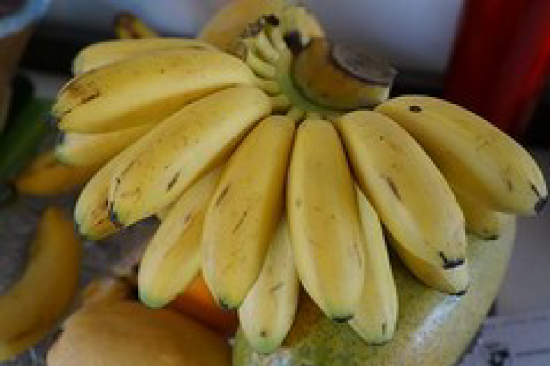
Plantains
Plantains, also referred to as cooking bananas, are larger than but not as sweet as common bananas. They are frequently cooked as a starchy vegetable in tropical cuisines.
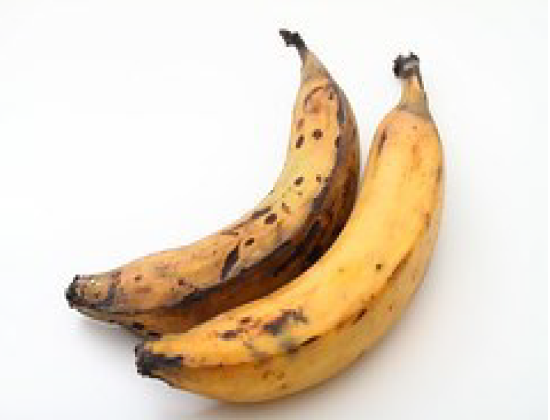
Dates
Dates are the fruit of the date palm tree, which has been cultivated since ancient times. Dates are about 1 to 2 inches (2.5 to 5 centimeters) long, with a paper-thin skin and a single grooved seed in the center. Most are golden to dark brown when ripe.
Although dates appear to be dried, they are actually fresh fruits. They have a sticky-sweet, almost candied texture and rich flavor. Dates provide flavor and moisture for breads, muffins, cookies and tarts. Additionally, they can be served with fresh or dried fruits, or stuffed with meat or cheese as an appetizer.
Pitted dates are readily available in several packaged forms: whole, chopped, or extruded (for use in baking). Whole un-pitted dates are available in bulk. Date juice is also available for use as a natural sweetener, especially in baked goods. Although packaged or processed dates are available all year, peak season for fresh domestic dates is from October through December. When selecting dates, look for those that are plump, glossy and moist.
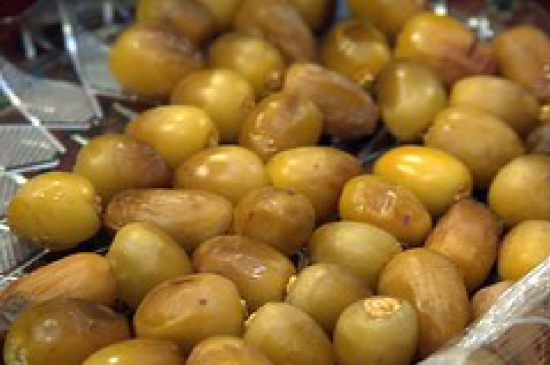
Kiwis
Kiwis, sometimes known as kiwifruits or Chinese gooseberries, are small oval fruits, about the size of a large egg, with a thin, fuzzy brown skin. The flesh is bright green with a white core surrounded by hundreds of tiny black seeds.
Kiwis are sweet, but somewhat bland. They are best used raw, peeled and eaten out of hand or sliced for fruit salads or garnish. Although kiwis are not recommended for cooking because heat causes them to fall apart, they are a perfect addition to glazed fruit tarts and can be pureed for sorbets, sauces or mousses. Kiwis contain an enzyme similar to that in fresh pineapple and papaya, which has a tenderizing effect on meat and prevents gelling.
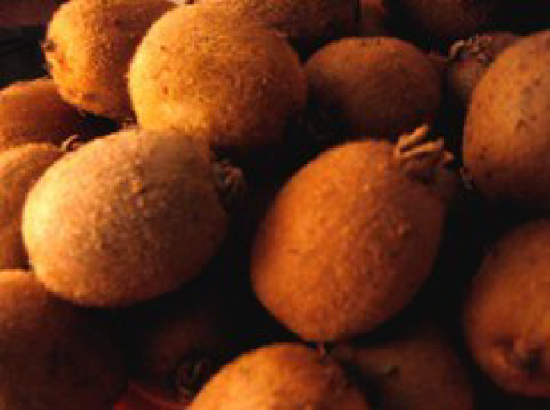
Mangoes
Mangoes are oval or kidney-shaped fruits that normally weigh between 6 ounces and 1 pound (180 and 500 grams). Their skin is smooth and thin but tough, varying from yellow to orange-red, with patches of green, reel or purple. As mangoes ripen, the green disappears. The juicy, bright orange flesh clings to a large, flat pit.
A mango's unique flavor is spicy-sweet, with an acidic tang. Mangoes can be pureed for use in drinks or sauces, or the flesh can be sliced or cubed for use in salads, pickles, chutneys or desserts. Mangoes go well with spicy foods such as curry and with barbecued meats.
Although Florida produces some mangoes, most of those available in the United States are from Mexico. Their peak season is from May through August. Select fruits with good color that are firm and free of blemishes. Ripe mangoes should have a good aroma, and should not be too soft or shriveled. Allow mangoes to ripen completely at room temperature, then refrigerate for up to 1 week. Ripe mangoes should have a good aroma, and should not be too soft or shriveled. Allow mangoes to ripen completely at room temperature, then refrigerate for up to one week.
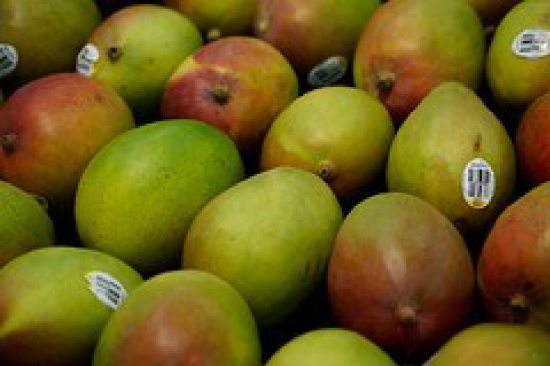
Papayas
The papaya is a greenish-yellow fruit shaped rather like a large pear and weighing 1 to 2 pounds (500 to 1000 grams). When halved, it resembles a melon. The flesh is golden to red dish-pink; its center cavity is filled with round, silver-black seeds resembling caviar. Ripe papayas can be eaten raw, with only a squirt of lemon or lime juice. They can also be pureed for sweet or spicy sauces, chilled soups or sorbets.
Papayas contain papain, which breaks down proteins, and therefore papayas are an excellent meat tenderizer. Meats can be marinated with papaya juice or slices before cooking. Papain, however, makes fresh papayas unsuitable for use in gelatins because it inhibits gelling. Unripe (green) papayas are often used in pickles, or chutneys, and can be baked, or stewed, with meat or poultry.
Papaya seeds are edible, with a peppery flavor and slight crunch. They are occasionally used to garnish fruit salads or add flavor to fruit salsa s and compotes. Papayas are grown in tropical and sub-tropical areas worldwide. Although they are available year-round, their peak season is from April through June. Select papayas that are plump, with a smooth, unblemished skin. Color is a better determinant of ripeness than is softness: The greater the proportion of yellow to green skin color, the riper the fruit. Papayas may be held at room temperature until completely ripe, then refrigerated for up to 1 week.
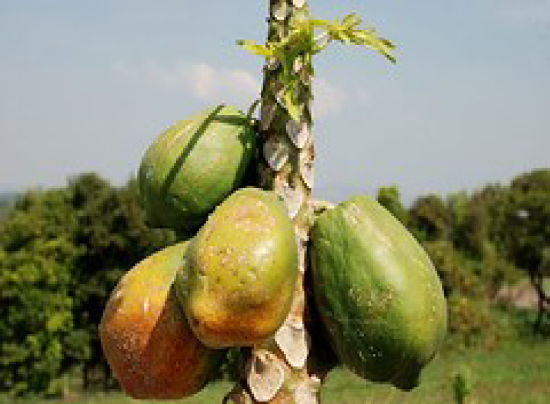
Passion Fruits
Passion fruits have a firm, almost shell-like purple skin with orange -yellow pulp surrounding large, black, edible seeds. They are about the size and shape of large hen eggs, with a sweet, rich and unmistakable citrusy flavor. The pulp is used in custards, sauces and ice creams.
Select heavy fruits with dark, shriveled skin and a strong aroma. Allow them to ripen at room temperature, if necessary, then refrigerate. Passion fruits are now grown in New Zealand, Hawaii and California and should be available all year, although their peak season is in February and March. Bottles or frozen packs of puree are readily available and provide a strong, true flavor.
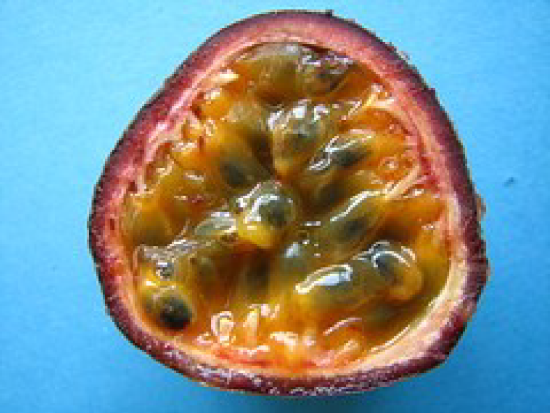
Pineapples
Pineapples are the fruit of a shrub with sharp spear -shaped leaves. Each fruit is covered with rough, brown eyes, giving it the appearance of a pinecone. The pale yellow flesh, which is sweet and very juicy, surrounds a cylindrical woody core that is edible but too tough for most uses. Most pineapples weigh approximately 2 pounds (1 kilogram), but dwarf varieties are also available.
Pineapples are excellent eaten raw, alone or in salads. Slices can be baked or grilled to accompany pork, or ham. The cuisines of Southeast Asia incorporate pineapple into various curries, soups and stews. Pineapple juice is a popular beverage often used in punch or cocktails. Canned or cooked pineapple can be added to gelatin mixtures, but avoid using fresh pineapple; an enzyme (bromelin) found in fresh pineapple breaks down gelatin.
Pineapples do not ripen after harvesting. They must be left on the stem until completely ripe, at which time they are extremely perishable. The vast majority of pineapples come from Hawaii. Fresh pineapples are available all year, with peak supplies in March through June. Select heavy fruits with a strong, sweet aroma and rich color. Avoid those with dried leaves or soft spots. Pineapples should be used as soon as possible after purchase. Pineapples are also available canned in slices, cubes or crushed, dried or candied.
